How Theoretical Approaches Improve Child Development Understanding
VerifiedAdded on 2020/04/13
|5
|1235
|55
Essay
AI Summary
This essay examines how theoretical approaches have enhanced the understanding of child development, particularly focusing on attachment theory and the nature versus nurture debate. It delves into the foundational work of John Bowlby and Mary Ainsworth, highlighting the significance of the mother-child bond and its impact on a child's development. The essay explores the stages of attachment, from pre-birth emotional connections to the development of secure base behavior in toddlerhood. Furthermore, it discusses the long-standing debate of nature versus nurture, examining how both genetic and environmental factors influence human behavior. The essay concludes by summarizing that the theoretical approaches have significantly improved our understanding of child development by providing a framework to understand human growth and behavior.
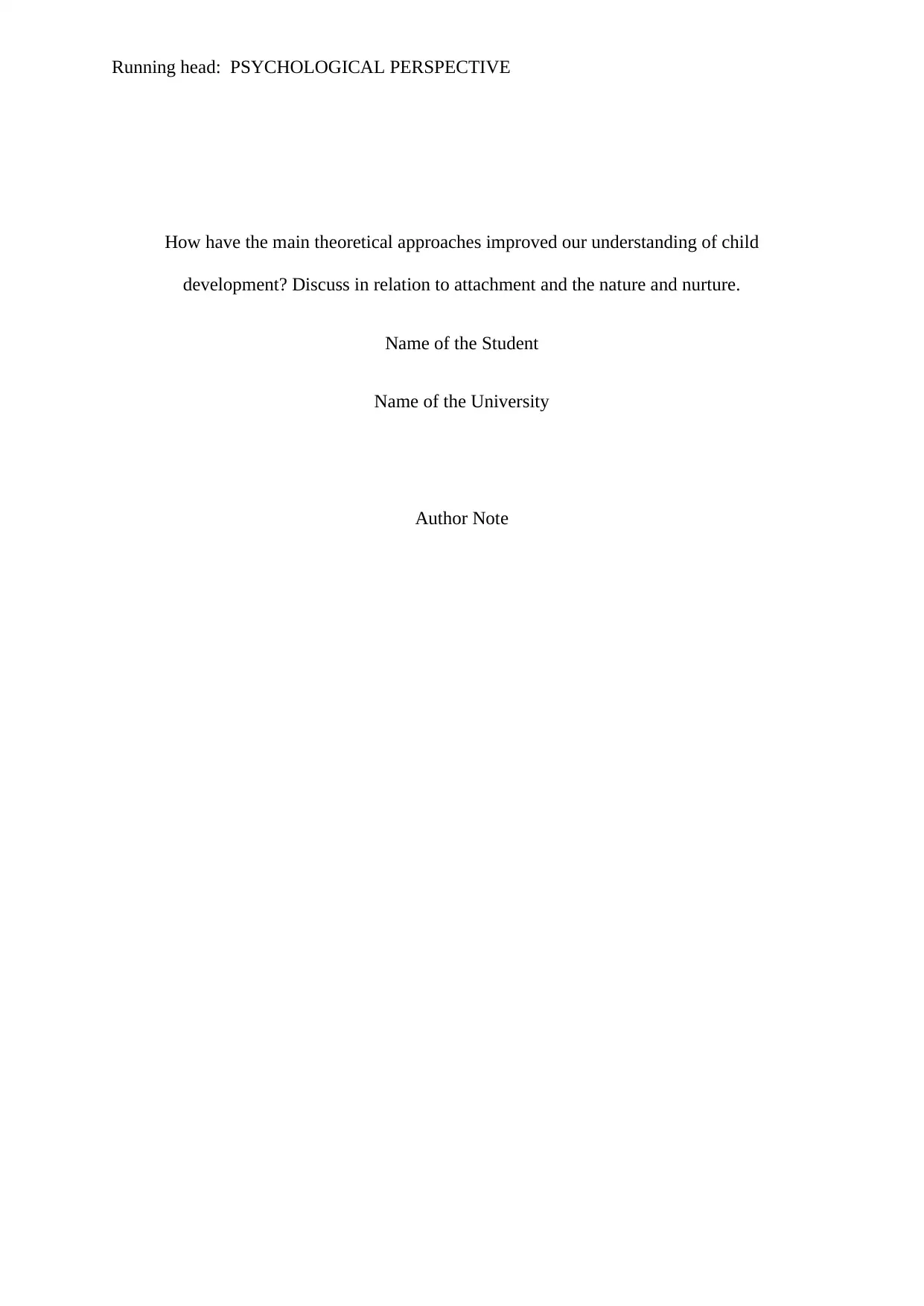
Running head: PSYCHOLOGICAL PERSPECTIVE
How have the main theoretical approaches improved our understanding of child
development? Discuss in relation to attachment and the nature and nurture.
Name of the Student
Name of the University
Author Note
How have the main theoretical approaches improved our understanding of child
development? Discuss in relation to attachment and the nature and nurture.
Name of the Student
Name of the University
Author Note
Paraphrase This Document
Need a fresh take? Get an instant paraphrase of this document with our AI Paraphraser
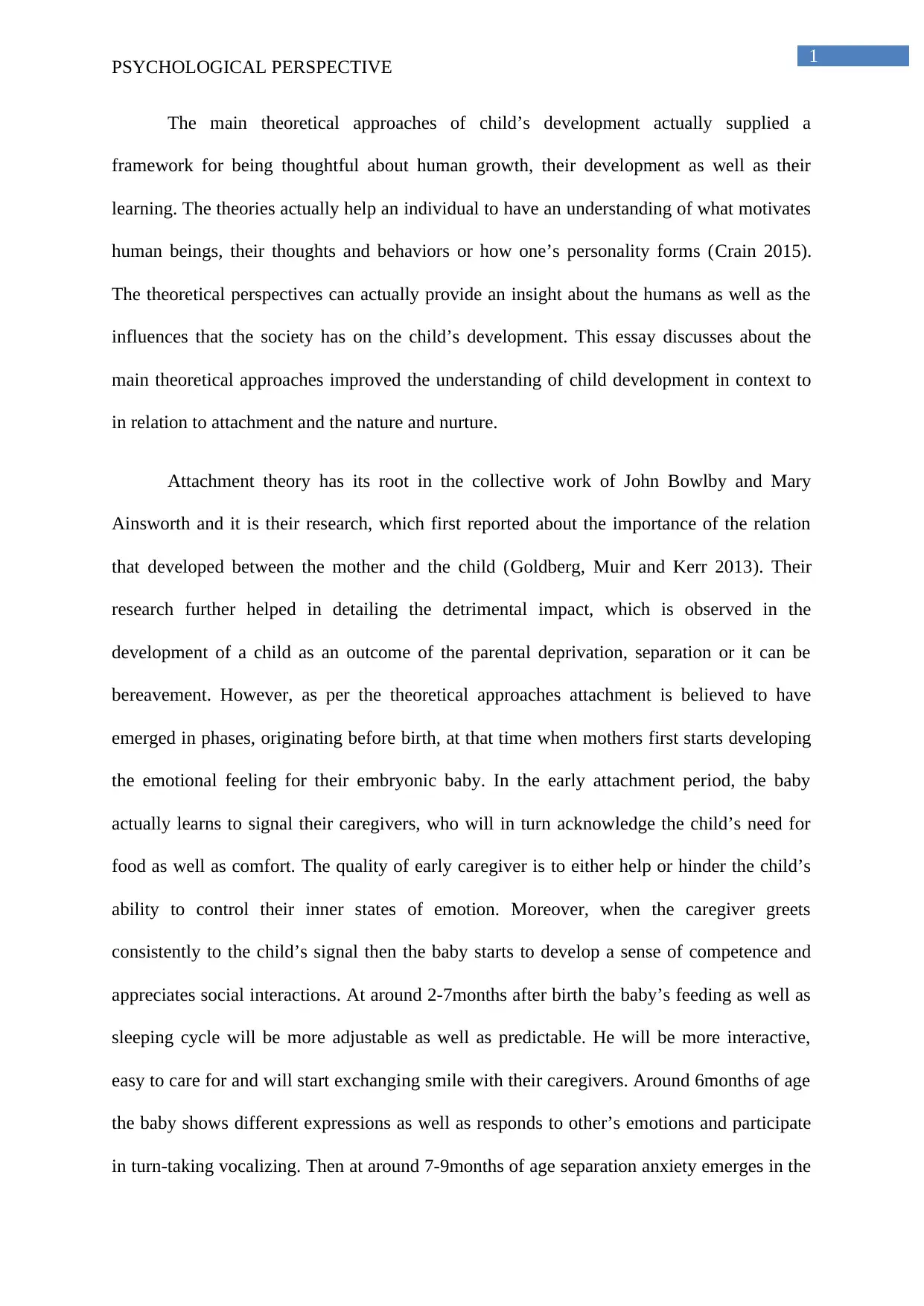
1
PSYCHOLOGICAL PERSPECTIVE
The main theoretical approaches of child’s development actually supplied a
framework for being thoughtful about human growth, their development as well as their
learning. The theories actually help an individual to have an understanding of what motivates
human beings, their thoughts and behaviors or how one’s personality forms (Crain 2015).
The theoretical perspectives can actually provide an insight about the humans as well as the
influences that the society has on the child’s development. This essay discusses about the
main theoretical approaches improved the understanding of child development in context to
in relation to attachment and the nature and nurture.
Attachment theory has its root in the collective work of John Bowlby and Mary
Ainsworth and it is their research, which first reported about the importance of the relation
that developed between the mother and the child (Goldberg, Muir and Kerr 2013). Their
research further helped in detailing the detrimental impact, which is observed in the
development of a child as an outcome of the parental deprivation, separation or it can be
bereavement. However, as per the theoretical approaches attachment is believed to have
emerged in phases, originating before birth, at that time when mothers first starts developing
the emotional feeling for their embryonic baby. In the early attachment period, the baby
actually learns to signal their caregivers, who will in turn acknowledge the child’s need for
food as well as comfort. The quality of early caregiver is to either help or hinder the child’s
ability to control their inner states of emotion. Moreover, when the caregiver greets
consistently to the child’s signal then the baby starts to develop a sense of competence and
appreciates social interactions. At around 2-7months after birth the baby’s feeding as well as
sleeping cycle will be more adjustable as well as predictable. He will be more interactive,
easy to care for and will start exchanging smile with their caregivers. Around 6months of age
the baby shows different expressions as well as responds to other’s emotions and participate
in turn-taking vocalizing. Then at around 7-9months of age separation anxiety emerges in the
PSYCHOLOGICAL PERSPECTIVE
The main theoretical approaches of child’s development actually supplied a
framework for being thoughtful about human growth, their development as well as their
learning. The theories actually help an individual to have an understanding of what motivates
human beings, their thoughts and behaviors or how one’s personality forms (Crain 2015).
The theoretical perspectives can actually provide an insight about the humans as well as the
influences that the society has on the child’s development. This essay discusses about the
main theoretical approaches improved the understanding of child development in context to
in relation to attachment and the nature and nurture.
Attachment theory has its root in the collective work of John Bowlby and Mary
Ainsworth and it is their research, which first reported about the importance of the relation
that developed between the mother and the child (Goldberg, Muir and Kerr 2013). Their
research further helped in detailing the detrimental impact, which is observed in the
development of a child as an outcome of the parental deprivation, separation or it can be
bereavement. However, as per the theoretical approaches attachment is believed to have
emerged in phases, originating before birth, at that time when mothers first starts developing
the emotional feeling for their embryonic baby. In the early attachment period, the baby
actually learns to signal their caregivers, who will in turn acknowledge the child’s need for
food as well as comfort. The quality of early caregiver is to either help or hinder the child’s
ability to control their inner states of emotion. Moreover, when the caregiver greets
consistently to the child’s signal then the baby starts to develop a sense of competence and
appreciates social interactions. At around 2-7months after birth the baby’s feeding as well as
sleeping cycle will be more adjustable as well as predictable. He will be more interactive,
easy to care for and will start exchanging smile with their caregivers. Around 6months of age
the baby shows different expressions as well as responds to other’s emotions and participate
in turn-taking vocalizing. Then at around 7-9months of age separation anxiety emerges in the
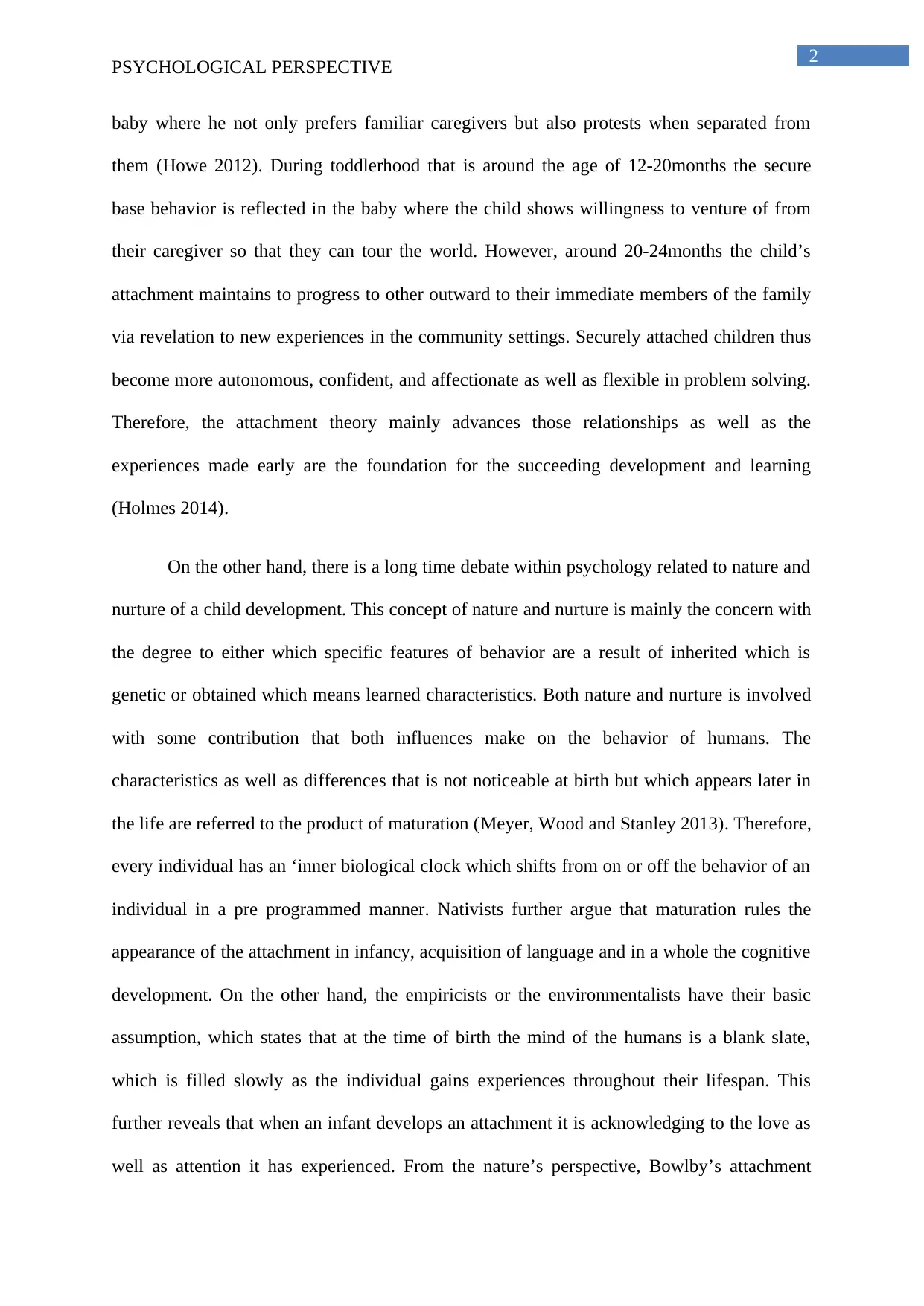
2
PSYCHOLOGICAL PERSPECTIVE
baby where he not only prefers familiar caregivers but also protests when separated from
them (Howe 2012). During toddlerhood that is around the age of 12-20months the secure
base behavior is reflected in the baby where the child shows willingness to venture of from
their caregiver so that they can tour the world. However, around 20-24months the child’s
attachment maintains to progress to other outward to their immediate members of the family
via revelation to new experiences in the community settings. Securely attached children thus
become more autonomous, confident, and affectionate as well as flexible in problem solving.
Therefore, the attachment theory mainly advances those relationships as well as the
experiences made early are the foundation for the succeeding development and learning
(Holmes 2014).
On the other hand, there is a long time debate within psychology related to nature and
nurture of a child development. This concept of nature and nurture is mainly the concern with
the degree to either which specific features of behavior are a result of inherited which is
genetic or obtained which means learned characteristics. Both nature and nurture is involved
with some contribution that both influences make on the behavior of humans. The
characteristics as well as differences that is not noticeable at birth but which appears later in
the life are referred to the product of maturation (Meyer, Wood and Stanley 2013). Therefore,
every individual has an ‘inner biological clock which shifts from on or off the behavior of an
individual in a pre programmed manner. Nativists further argue that maturation rules the
appearance of the attachment in infancy, acquisition of language and in a whole the cognitive
development. On the other hand, the empiricists or the environmentalists have their basic
assumption, which states that at the time of birth the mind of the humans is a blank slate,
which is filled slowly as the individual gains experiences throughout their lifespan. This
further reveals that when an infant develops an attachment it is acknowledging to the love as
well as attention it has experienced. From the nature’s perspective, Bowlby’s attachment
PSYCHOLOGICAL PERSPECTIVE
baby where he not only prefers familiar caregivers but also protests when separated from
them (Howe 2012). During toddlerhood that is around the age of 12-20months the secure
base behavior is reflected in the baby where the child shows willingness to venture of from
their caregiver so that they can tour the world. However, around 20-24months the child’s
attachment maintains to progress to other outward to their immediate members of the family
via revelation to new experiences in the community settings. Securely attached children thus
become more autonomous, confident, and affectionate as well as flexible in problem solving.
Therefore, the attachment theory mainly advances those relationships as well as the
experiences made early are the foundation for the succeeding development and learning
(Holmes 2014).
On the other hand, there is a long time debate within psychology related to nature and
nurture of a child development. This concept of nature and nurture is mainly the concern with
the degree to either which specific features of behavior are a result of inherited which is
genetic or obtained which means learned characteristics. Both nature and nurture is involved
with some contribution that both influences make on the behavior of humans. The
characteristics as well as differences that is not noticeable at birth but which appears later in
the life are referred to the product of maturation (Meyer, Wood and Stanley 2013). Therefore,
every individual has an ‘inner biological clock which shifts from on or off the behavior of an
individual in a pre programmed manner. Nativists further argue that maturation rules the
appearance of the attachment in infancy, acquisition of language and in a whole the cognitive
development. On the other hand, the empiricists or the environmentalists have their basic
assumption, which states that at the time of birth the mind of the humans is a blank slate,
which is filled slowly as the individual gains experiences throughout their lifespan. This
further reveals that when an infant develops an attachment it is acknowledging to the love as
well as attention it has experienced. From the nature’s perspective, Bowlby’s attachment
⊘ This is a preview!⊘
Do you want full access?
Subscribe today to unlock all pages.

Trusted by 1+ million students worldwide
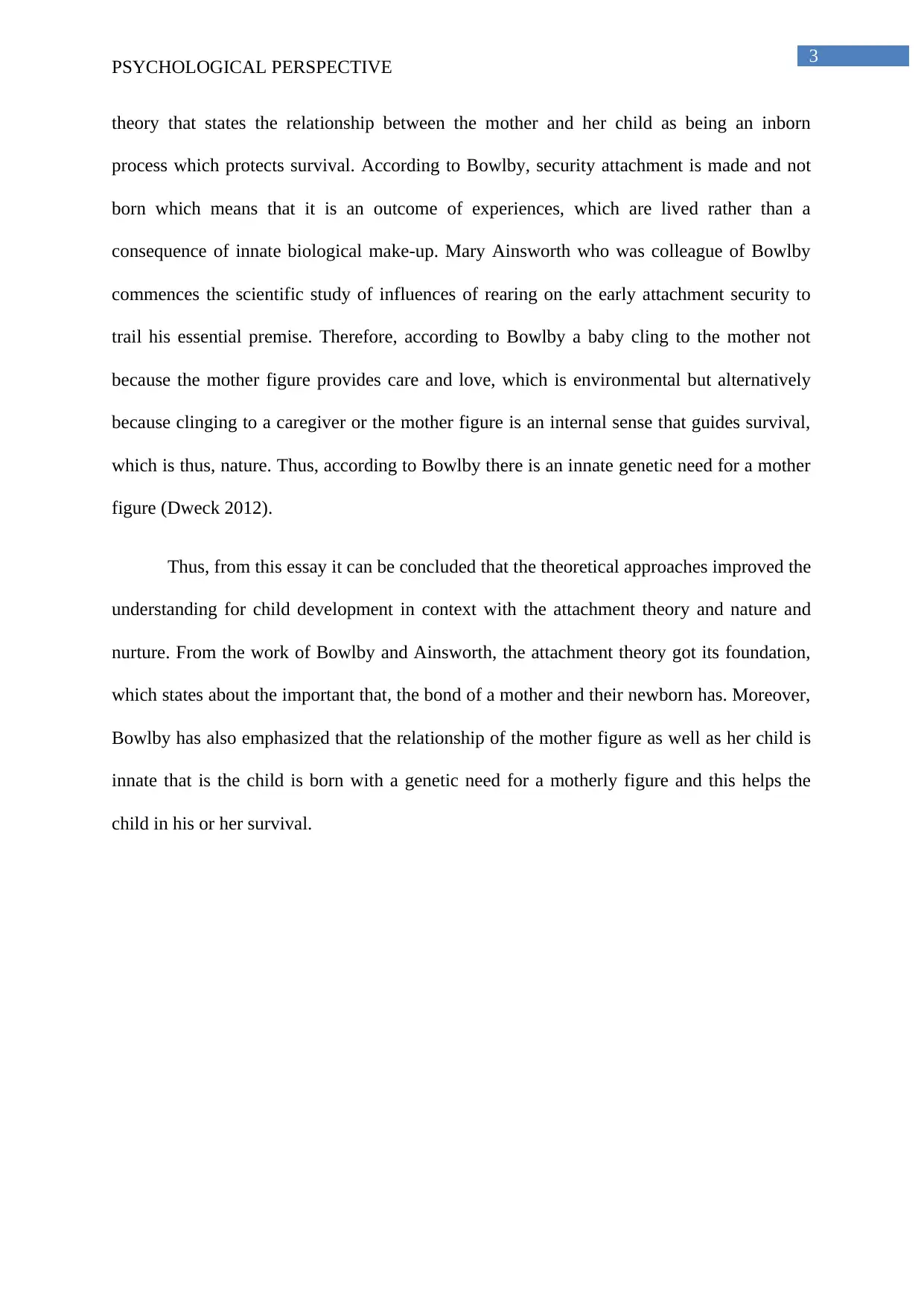
3
PSYCHOLOGICAL PERSPECTIVE
theory that states the relationship between the mother and her child as being an inborn
process which protects survival. According to Bowlby, security attachment is made and not
born which means that it is an outcome of experiences, which are lived rather than a
consequence of innate biological make-up. Mary Ainsworth who was colleague of Bowlby
commences the scientific study of influences of rearing on the early attachment security to
trail his essential premise. Therefore, according to Bowlby a baby cling to the mother not
because the mother figure provides care and love, which is environmental but alternatively
because clinging to a caregiver or the mother figure is an internal sense that guides survival,
which is thus, nature. Thus, according to Bowlby there is an innate genetic need for a mother
figure (Dweck 2012).
Thus, from this essay it can be concluded that the theoretical approaches improved the
understanding for child development in context with the attachment theory and nature and
nurture. From the work of Bowlby and Ainsworth, the attachment theory got its foundation,
which states about the important that, the bond of a mother and their newborn has. Moreover,
Bowlby has also emphasized that the relationship of the mother figure as well as her child is
innate that is the child is born with a genetic need for a motherly figure and this helps the
child in his or her survival.
PSYCHOLOGICAL PERSPECTIVE
theory that states the relationship between the mother and her child as being an inborn
process which protects survival. According to Bowlby, security attachment is made and not
born which means that it is an outcome of experiences, which are lived rather than a
consequence of innate biological make-up. Mary Ainsworth who was colleague of Bowlby
commences the scientific study of influences of rearing on the early attachment security to
trail his essential premise. Therefore, according to Bowlby a baby cling to the mother not
because the mother figure provides care and love, which is environmental but alternatively
because clinging to a caregiver or the mother figure is an internal sense that guides survival,
which is thus, nature. Thus, according to Bowlby there is an innate genetic need for a mother
figure (Dweck 2012).
Thus, from this essay it can be concluded that the theoretical approaches improved the
understanding for child development in context with the attachment theory and nature and
nurture. From the work of Bowlby and Ainsworth, the attachment theory got its foundation,
which states about the important that, the bond of a mother and their newborn has. Moreover,
Bowlby has also emphasized that the relationship of the mother figure as well as her child is
innate that is the child is born with a genetic need for a motherly figure and this helps the
child in his or her survival.
Paraphrase This Document
Need a fresh take? Get an instant paraphrase of this document with our AI Paraphraser
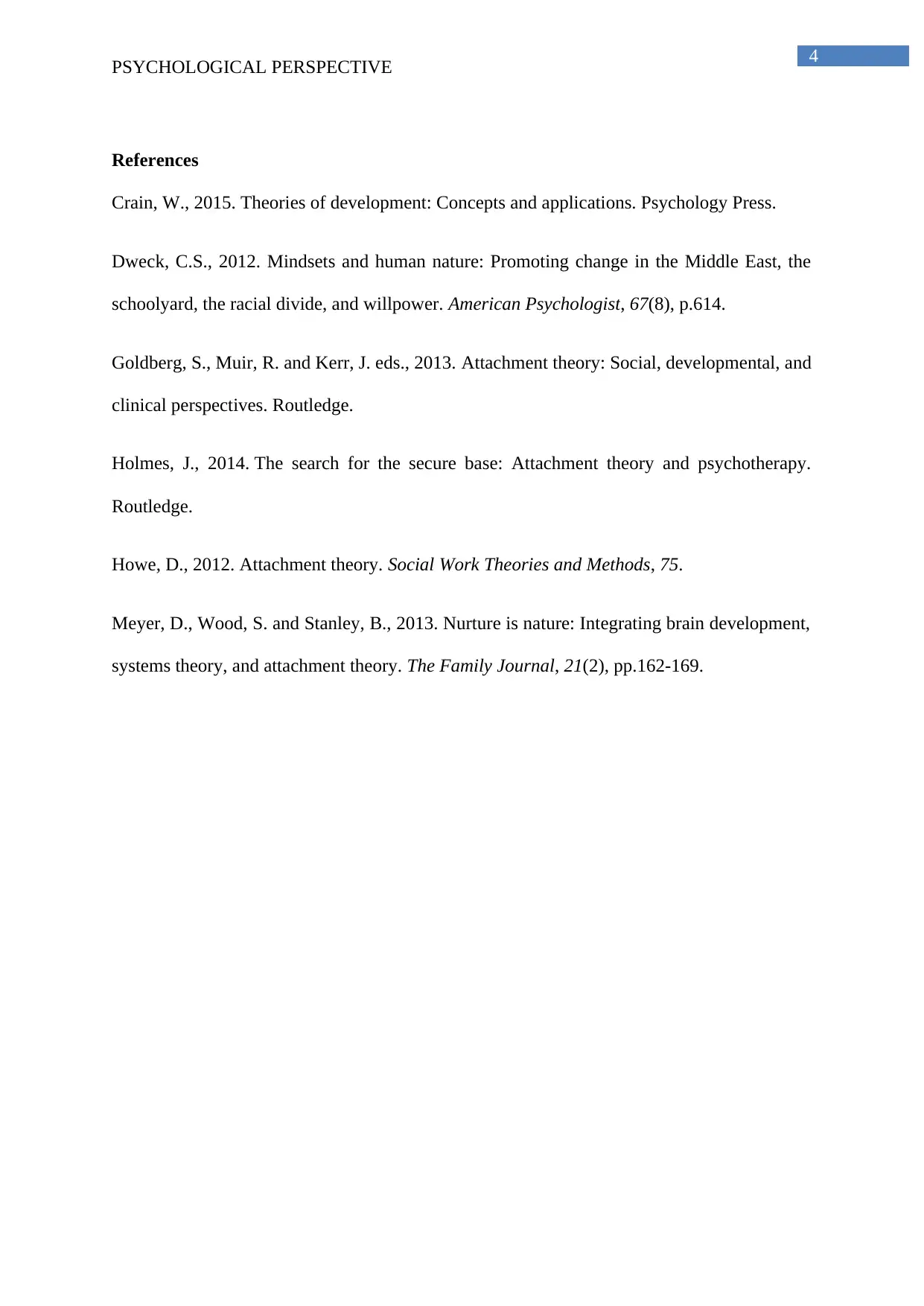
4
PSYCHOLOGICAL PERSPECTIVE
References
Crain, W., 2015. Theories of development: Concepts and applications. Psychology Press.
Dweck, C.S., 2012. Mindsets and human nature: Promoting change in the Middle East, the
schoolyard, the racial divide, and willpower. American Psychologist, 67(8), p.614.
Goldberg, S., Muir, R. and Kerr, J. eds., 2013. Attachment theory: Social, developmental, and
clinical perspectives. Routledge.
Holmes, J., 2014. The search for the secure base: Attachment theory and psychotherapy.
Routledge.
Howe, D., 2012. Attachment theory. Social Work Theories and Methods, 75.
Meyer, D., Wood, S. and Stanley, B., 2013. Nurture is nature: Integrating brain development,
systems theory, and attachment theory. The Family Journal, 21(2), pp.162-169.
PSYCHOLOGICAL PERSPECTIVE
References
Crain, W., 2015. Theories of development: Concepts and applications. Psychology Press.
Dweck, C.S., 2012. Mindsets and human nature: Promoting change in the Middle East, the
schoolyard, the racial divide, and willpower. American Psychologist, 67(8), p.614.
Goldberg, S., Muir, R. and Kerr, J. eds., 2013. Attachment theory: Social, developmental, and
clinical perspectives. Routledge.
Holmes, J., 2014. The search for the secure base: Attachment theory and psychotherapy.
Routledge.
Howe, D., 2012. Attachment theory. Social Work Theories and Methods, 75.
Meyer, D., Wood, S. and Stanley, B., 2013. Nurture is nature: Integrating brain development,
systems theory, and attachment theory. The Family Journal, 21(2), pp.162-169.
1 out of 5
Related Documents
Your All-in-One AI-Powered Toolkit for Academic Success.
+13062052269
info@desklib.com
Available 24*7 on WhatsApp / Email
![[object Object]](/_next/static/media/star-bottom.7253800d.svg)
Unlock your academic potential
Copyright © 2020–2025 A2Z Services. All Rights Reserved. Developed and managed by ZUCOL.





